Thinking back about our previous entries about Nepal, we had made very mixed experiences. To give the country another chance, we wanted to find out how they would treat us at the less touristy spots. Thus, we made our long journey to the north-west to visit “Bardia National Park”, the remote alternative to Chitwan, the latter being a popular place on the standard route to India. The dialogue preceding our decision was like follows:
“Hey Thomas, that sounds cool. In Bardia we can do a walking safari.”
“Mmhh, okay ….”
“Wow, and here in the travel guide it is said that sometimes rhino and tiger attack. Hence, they say the walking safari can be a real danger.”
“Booked!”
But of course, this was an exaggeration. We were heavily armed, all of us carrying a massive bamboo stick. Our guide had done a 7 days training program and gave us a 30 seconds introduction about what to do in case of an emergency:
rhinos –> run zigzags and find a tree to climb on
tigers, elephants, crocodiles –> normally won’t attack at all …. let’s go!
Speaking seriously, there has never been a casualty caused by wild animals in Bardia and the guides are all really experienced, having grown up and worked there for many years.
The name “walking safari” may be a bit misleading, because most of the time is a “waiting safari”. In fact, you go to the most promising places, which already gives you a good experience of the jungle, with its monkeys, birds and deer. Then you wait for several hours – hidden in the trees and silently – and hope for the “star-animal” to appear. Our guides worked very hard to make the most of our trip and always called each other to know what’s going on at the different spots. And according to our travel guide, we had exceptionally good luck: if it is the current dry season and you have lots of hot days without rain, the animals are forced to come to the river for drinking and having a refreshing bath. This is what happened during our stay and with a tiny extra portion of luck, we saw the best of the best in Bardia. Not only crocodiles, but also a mother rhino with her baby, and above all a tiger. We have to admit that the tiger was quite far away, so our small camera was not able to capture it appropriately. But it was not too far to be recognized with the bare eye and to be seen in detail with the binoculars. And definitely it was close enough to leave us fascinated by this animal’s majesty.
After this exhausting 12 hours safari and the 15 hours bus ride the day before, we decided to stay one day more. We slept late, relaxed most of the time, took a walk through the neighboring village with its surprisingly friendly inhabitants, had fun while swimming with some local kids in the cleanest Nepali river, and in the evening we went to the nearby elephant breading station. Actually they are working animals but after work it is time for pleasure and the result could be seen now: a cute little elephant baby born on Valentine’s Day 2013 and therefore called “Love”. He was surprisingly curious, wanted to touch the tourists even more than they wanted to touch him, but was still a bit clumsy.
As told at the beginning, our other purpose was to discover a different side of Nepal. And we were not disappointed, indeed it was the best stay we had here. It started already during the bus ride. The man at the counter was super helpful, let us use his mobile phone and took care that we would change to the right bus for the last 50km. We arrived 3 hours late and were not able to inform the guest-house owner, who was supposed to pick us up. After our previous experiences, we would never have expected it, but he just waited all the time – what a reliable person. At the guest-house (Bardia Wildlife Resort), the atmosphere was totally different. There were many young people of our age working there and interaction was – in contrast to our first days in Nepal – uncomplicated. We never had denied that Nepalis play at the same level, but here eventually they thought so, too. In the evenings, they simply joined our dinner and we talked and learned a lot from each other. We really admire them for what they have achieved. Most of them did not have the opportunity to go to school very long, but they do a great job as guide, speak English fluently (not just for the tourist business) and master the complex business of organizing the lodge and safaris. Yet another thing we have realized: we are used to stories of the war, but hearing them from people of our age is quite a different thing. At this evening, we were really touched by what they told us and how they told it. And at this lodge, we noted an additional positive aspect. Given the difficult situation of women in Nepal (more on this later), we were quite surprised that our guide was Hira, the owner’s wife. After they married very young, she learnt being a guide and together with her husband Shankhar, they built up this successful company. So the best you could wish for the country is more people like in this region, especially Hira, Shankhar and their employees.
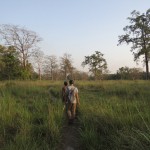
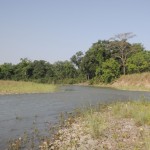
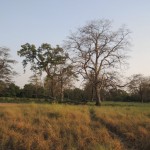
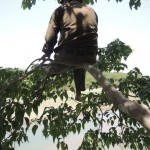
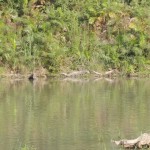
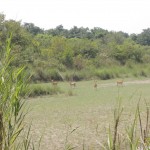
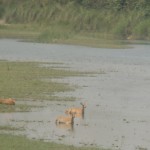
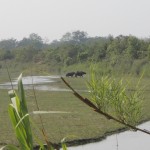
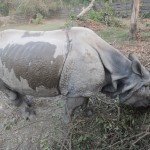
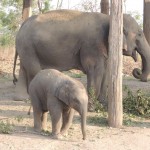
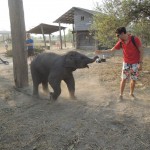
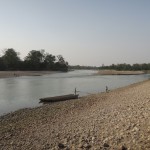
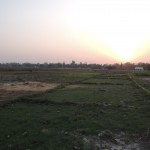
Aah! “Rhino”, “Crocodile” etc. c’est quand même mieux que “Animal 1″, “Animal 2″!
Bravo à tous pour la patience.